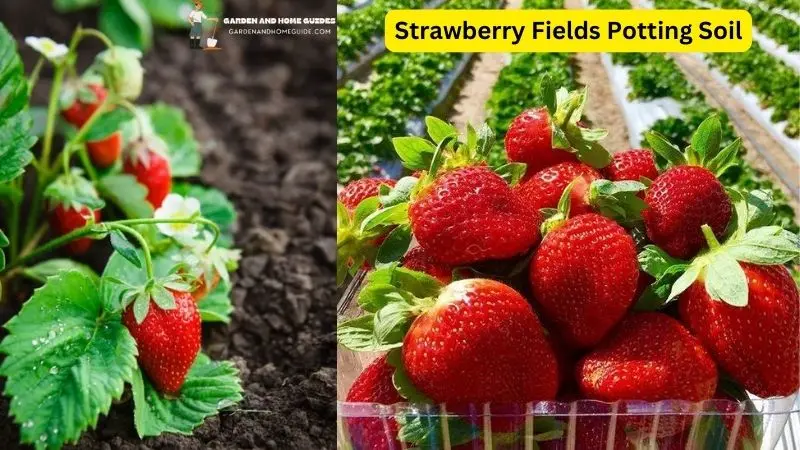Life Tips
Strawberry Fields Potting Soil
The allure of fresh, juicy strawberries, bursting with flavor and vibrant red hues, is undeniable. For many, the dream of cultivating these delights at home, amidst the comforting scent of blooming flowers and the gentle hum of bees, is a cherished aspiration. But behind the idyllic image of a flourishing strawberry patch lies a crucial element often overlooked: the foundation upon which these delicate plants thrive – strawberry fields potting soil.
This seemingly simple component plays a pivotal role in determining the success of your strawberry harvest. It’s not just about providing a medium for roots to anchor themselves; it’s about creating a nurturing environment that caters to the unique needs of these demanding plants. This essay of Gardenandhomeguide.com delves into the intricacies of strawberry fields potting soil, exploring its composition, ideal characteristics, and the impact it has on the health and productivity of your strawberry plants.
The Importance of Soil Composition:
The foundation of a thriving strawberry patch is a well-chosen potting soil. Unlike many other plants, strawberries require a specific blend of ingredients to flourish. The ideal strawberry fields potting soil is a symphony of components, each playing a vital role in supporting plant growth:
- Organic Matter: This is the lifeblood of the soil, providing essential nutrients and improving soil structure. Compost, aged manure, and peat moss are valuable additions, enhancing water retention, aeration, and nutrient availability.
- Perlite and Vermiculite: These lightweight, porous materials contribute to excellent drainage, preventing root rot and ensuring proper aeration. They also retain moisture, creating a balanced environment for optimal root growth.
- Nutrient Content: Strawberries are heavy feeders, demanding a balanced supply of essential nutrients like nitrogen, phosphorus, and potassium. The soil should provide a steady release of these nutrients throughout the growing season.
- pH Level: Strawberries prefer a slightly acidic soil with a pH range of 5.5 to 6.5. A soil test can determine the current pH level, and amendments like sulfur or lime can be used to adjust it accordingly.
The Impact of Soil Characteristics:
The composition of strawberry fields potting soil directly influences the health and productivity of your plants. Here’s how:
- Drainage: Poor drainage can lead to root rot, a common problem for strawberries. The ideal soil should allow excess water to drain quickly, preventing waterlogging.
- Aeration: Good aeration ensures that roots have access to oxygen, which is crucial for their growth and development. A well-aerated soil promotes healthy root systems and vigorous plant growth.
- Nutrient Availability: The soil must provide a steady supply of essential nutrients throughout the growing season. A balanced nutrient profile ensures healthy foliage, abundant flowering, and plentiful fruit production.
- Water Retention: Strawberries require consistent moisture, but excessive dryness can stress the plants. The soil should retain moisture without becoming waterlogged, providing a balanced environment for optimal growth.
Choosing The Right Strawberry Fields Potting Soil:
With the understanding of the ideal characteristics of strawberry fields potting soil, you can confidently select the best option for your strawberry patch. Here are some factors to consider:
- Pre-mixed Potting Soil: Many commercial brands offer pre-mixed potting soil specifically designed for strawberries. These blends typically contain a balanced mix of organic matter, perlite, vermiculite, and nutrients. Check the label for the pH level and nutrient content to ensure it meets the specific needs of your plants.
- DIY Soil Mix: For those who prefer a more personalized approach, creating your own strawberry fields potting soil mix can be rewarding. Start with a base of good quality potting soil and add amendments like compost, aged manure, perlite, and vermiculite. Adjust the proportions based on your soil’s existing characteristics and the specific needs of your strawberry plants.
- Soil Testing: Regardless of your chosen soil mix, it’s essential to conduct a soil test to determine the pH level and nutrient content. This information will guide you in making necessary adjustments to ensure optimal growing conditions for your strawberries.
Maintaining Healthy Soil:
Once you’ve established your strawberry patch, maintaining healthy soil is crucial for long-term success. Here are some key practices:
- Mulching: Applying a layer of organic mulch, such as straw, wood chips, or shredded bark, helps retain moisture, suppress weeds, and regulate soil temperature.
- Fertilizing: Strawberries require regular fertilization to replenish nutrients depleted during growth. Use a balanced fertilizer specifically formulated for strawberries, following the recommended application rates.
- Watering: Consistent watering is essential, especially during dry periods. Water deeply and infrequently, allowing the top layer of soil to dry slightly between waterings.
- Rotation: Avoid planting strawberries in the same spot year after year. Rotating crops helps prevent soilborne diseases and pests.
Conclusion:
The success of your strawberry patch hinges on the quality of strawberry fields potting soil. By understanding the importance of soil composition, choosing the right blend, and maintaining healthy soil conditions, you can create a thriving environment for your plants to flourish. With careful attention to detail and a passion for growing these delightful fruits, your strawberry patch can become a source of pride, providing you with an abundance of fresh, juicy strawberries for years to come.






